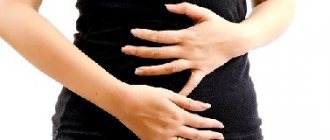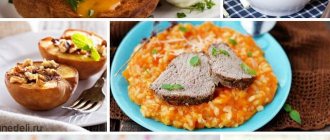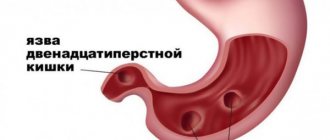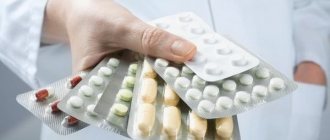Complex therapy for inflammatory diseases of the stomach and intestines involves a number of measures aimed at speedy recovery of the patient. The effectiveness of medication directly depends on the correct diet. When prescribing a menu, the gastroenterologist takes into account the type of pathology, the stage of the process and the severity of the condition.
The diet for erosive bulbitis of the duodenum has its own characteristics. The main tasks are the elimination of unfavorable symptoms, the creation of gentle conditions to ensure normal acidity and epithelization of the mucous membrane, and normalization of the motor function of the upper digestive tract. Therefore, drawing up a detailed diet is an important stage of treatment.
What is duodenal bulbitis?
The disease can be acute or chronic. Bulbit is a lesion of the duodenal bulb (duodenum), in which inflammation of the mucous membrane develops with dysfunction of the digestive tract. Most often the damage is superficial, however, in some cases, erosions and other pathological defects of the epithelium are formed.
The rapid development of the process occurs against the background of poisoning, injuries, burns, and surgical interventions. Therefore, such patients have a clear clinical picture. In chronic inflammation, the main cause is Helicobacter pylori infection.
Other factors are:
- polypous growths;
- autoimmune mechanisms;
- poor nutrition;
- stress.
Symptoms develop gradually, the signs are mild or moderate, mainly after a diet violation.
What is duodenal ulcer and how to treat it
Causes of polyps in the stomach
Classification
According to the international classification, there are two types of true inflammation of the duodenal bulb - erosive and ulcerative. Gastroenterologists use an expanded model, which is based on endoscopic signs. The diet for duodenal bulbitis depends on this. Types of pathology are presented in the table.
Table 1. Classification
| Criteria | Options |
| According to the time of development of the disease | spicy; chronic |
| According to the prevalence of the process | focal; diffuse |
| According to morphological characteristics | surface; catarrhal; erosive; atrophic; hyperplastic; erosive-hemorrhagic; follicular |
Symptoms and treatment
Manifestations of acute pathology are characterized by a sudden onset and pronounced clinical manifestations. Most often, such patients are hospitalized with complications, which include bleeding, perforation and penetration of the defect. There is a sharp deterioration in the condition, which is characterized by:
- an increase in pain in the epigastric and umbilical region;
- increased temperature;
- vomiting;
- melena;
- severe weakness;
- decreased blood pressure;
- pallor of the skin.
Symptoms of bulbitis and inflammation of the stomach against the background of a chronic course of the disease develop gradually and cause little concern to the patient. Most often, patients complain of:
- discomfort after eating immediately or after a short period of time;
- nausea;
- heartburn;
- belching bitter;
- bloating;
- unstable stool, often in the form of constipation;
- fatigue, decreased performance, sleep disturbance.
Important! The severity of clinical signs depends on the prevalence of the inflammatory process.
Reviews and results
Nutritional treatment is important for gastrointestinal diseases. It is not necessary to adhere to strict restrictions all the time, but during an exacerbation it is necessary. The composition of the main Table No. 1 is varied and complete, so it is suitable for constant nutrition. Feedback from patients confirms the need for therapeutic nutrition and its effectiveness.
- “... I was worried about nausea and belching, discomfort in the stomach, pain when pressing on it. Gastroscopy - superficial gastritis and bulbitis. Helicobacter was found. I took an antibiotic for a week and Ganaton for a month. I was also prescribed a diet that helps me. In general, I noticed that if I eat something rough or irritating (garlic, onions, horseradish, even radishes), pain and aggravation appear. I came to the conclusion that I need to follow the diet constantly. Porridge with milk and milk came up. I cooked soups first with water, and then with weak chicken broth. At first I ate well-cooked cereal soups, then I started making vegetable soups, but I crushed the vegetables or lightly beat them in a blender. I cooked cutlets and omelettes in a double boiler. I stuck to this diet for 2 months, and I managed to eliminate inflammation in the stomach and lose weight.”
- “... I consider this diet beneficial for the stomach and health in general. The diet is well tolerated and the lack of fried foods doesn’t bother me. I cook fish or chicken cutlets in a double boiler or in the oven (I hardly brown them), but the taste changes a little. I noticed that when an exacerbation begins, you need not to let the situation go, but immediately switch to dietary nutrition, excluding spicy foods, spices, fried and pickled vegetables. All this makes me feel worse. So for stomach diseases, the main thing is to eat right.”
What nutrition should be like: principles and recommendations
The principles of nutrition for different types of gastrointestinal pathology have similar features. The menu is developed taking into account the stage of the disease. In the acute period, the diet is the most gentle, taking into account the pronounced inflammatory changes. As the process subsides, the diet is expanded, including various products in boiled, baked, stewed form.
Nutrition for duodenal bulbitis at the beginning of treatment is limited to carbohydrate foods. Subsequently, protein foods and fats are added.
Gastroenterologists recommend eating up to six times a day and not taking long breaks between meals.
You can't eat:
- spicy;
- smoked;
- roast;
- drink alcohol;
- strong coffee;
- carbonated drinks with dyes.
Strict restrictions are observed for 1-2 weeks, then the list of permitted products is expanded. You should adhere to the correct regimen for several months, or better yet, throughout your life.
Recommended dietary tables according to Pevzner
When developing a menu, the gastroenterologist is guided not only by the nosological form of the disease, but also by the concomitant pathology. For this purpose, there is an indicative table of Pevsner tables. It takes into account the patient’s nutritional characteristics during exacerbation, chronic process and during the recovery period.
The diet for erosive bulbitis includes table 1, which is divided into two subgroups:
- 1a - food is prepared liquid, jelly-like, mushy, with maximum mechanical and chemical sparing of the mucous membrane of the stomach and duodenum. Diet 1a is prescribed in the acute period of superficial and focal bulbitis, in hyperacid conditions, and ulcerative processes.
- 1b - suggested for a gradual transition to the main diet. Dishes are served in pureed, mashed form, with expansion due to protein products.
General requirements for this table include limiting table salt and subsidizing vitamins A, B, C.
If there is atrophy of the mucous membrane due to chronic gastroduodenitis, table 2 is recommended. Light frying without breading, diluted sour juices are allowed, and foods that are difficult to digest are excluded.
In case of concomitant pathology of the intestines, liver, or dyskinesia of the gallbladder, it is recommended to switch to diet No. 3 or No. 5. During the period of convalescence (recovery), they adhere to table No. 15. The menu contains a complete diet, except for fatty and spicy dishes.
General dietary rules
Treatment of bulbitis should begin with determining the required diet and optimal diet. Meals should be fractional. It should include:
- fermented milk products (kefir),
- liquid porridge,
- jelly,
- low-fat broths,
- crackers instead of bread.
Salty, sour, smoked and especially fatty foods, as well as seasonings and spices, are excluded from the diet.
Food should be taken in a warm, semi-liquid form. A properly balanced diet is not only the key to successful treatment of the disease, but an excellent preventive method against bulbitis and other gastrointestinal diseases. You should completely abstain from smoking and alcohol.
List of allowed and prohibited foods for duodenal bulbitis
Inflammatory pathology of the duodenal bulb requires following a diet for 1-3 months, depending on the degree of damage to the mucous membrane. During the acute and subacute period, they adhere to a certain diet.
Foods that adults can eat:
- flour products - mainly dry baked goods and biscuits, wheat bread;
- soups - pureed milk and vegetable soups with the addition of potatoes and cereals, other vegetables (except white cabbage);
- chopped meat dishes or meat in small pieces, jelly - from turkey, chicken, beef, rabbit (low-fat varieties);
- seafood - steamed or jellied fish - pike perch, hake, cod;
- finely ground porridge, oats, except millet;
- cereal puddings and souffles;
- small pasta;
- curd mass and soufflé, whole and condensed milk, low-fat sour cream, unsalted cream-based butter;
- vegetable dishes from carrots, beets, potatoes, zucchini, pumpkin;
- fruit puree from bananas, apples, pears, peaches, mousses, jams, preserves;
- drinks in the form of jelly, tea and cocoa with milk, rosehip decoction, sweet fruit juices, carrot juice;
- eggs in omelet form and boiled.
There are prohibited foods for bulbitis.
During an exacerbation of the disease, you should not eat:
- bakery products made from rye flour and yeast based;
- decoctions of meat, fish, mushrooms, jellied meat;
- legumes, millet;
- full-fat sour cream, cream, sharp cheese;
- red and white cabbage, spinach, radish, raw onion and garlic;
- fruits and sour-tasting juices from grapes, berries;
- marinades, pickles, smoked meats.
What can you eat?
The following foods are allowed to be eaten:
- steamed omelettes, soft-boiled eggs;
- slimy porridge;
- vegetarian soups containing vegetables and cereals, pureed through a sieve; it is possible to season the soup with butter;
- various jelly, including dairy;
- low-fat boiled fish (meat) in the form of puree, or cooked in a double boiler;
- baked apples, pumpkin;
- mashed potatoes;
- boiled milk;
- cocoa with milk;
- broth with chicken.
After the first week of illness, the following foods are gradually allowed to be added to the food list:
- crackers;
- buckwheat porridge (rice, oatmeal) in water with the addition of milk, flavored with butter;
- low fat cottage cheese;
- sour cream (not rustic);
- steamed chicken or pork cutlets;
- greens and oven-cooked vegetables;
- some types of vermicelli;
- boiled ham;
- juices and compotes from vegetables and fruits;
- biscuit.
During the chronic form of the disease, the diet is allowed to be slightly weakened. The calorie content of the diet per day should be in the region of 2500-3000 kcal, and the weight of food should be up to 3 kg. Each serving should contain about 100 g of protein, 90 g of fat and 400 g of carbohydrates. The temperature of the food should not exceed 55 degrees and at the same time be above +15. Be sure to give up all kinds of semi-finished products.
Sample menu for a week for duodenal bulbitis
Nutrition for duodenal bulbitis should be balanced in terms of main components and calories. This is very important, given the disruption of the digestive process and the increasing deficiency of nutrients. Therefore, the gastroenterologist must offer the patient several menu options for bulbitis. It is advisable to include different first and second courses to fill the need for the necessary elements and restore food tolerance.
Menu for a week for duodenal bulbitis and gastritis
When a patient has inflammation of the stomach and duodenum, the daily amount of food should be divided into 6 meals. Prepare 3 main courses and 3 snacks. The diet for bulbitis is identical to the menu for gastritis, taking into account similar approaches to therapy. A sample diet looks like this:
Monday
| Watch | Menu |
| 8.00 | Rice porrige; tea with milk |
| 10.30 | Cottage cheese casserole |
| 13.00 | Vegetable puree soup with pumpkin and zucchini; boiled chicken breast; mashed potatoes; plum compote |
| 16.00 | Fruit soufflé |
| 18.30 | Oatmeal; meatballs in sour cream sauce; cocoa |
| 20.30 | Yogurt; toast |
Tuesday
| Watch | Menu |
| 8.00 | Steamed egg omelet; tea |
| 10.30 | Fruit salad |
| 13.00 | Buckwheat soup; vegetable stew; beef meatballs; rosehip decoction |
| 16.00 | Apple juice is sweet with pulp; cookie |
| 18.30 | Rice pudding; steamed chicken meatballs; apple compote |
| 20.30 | Galette cookies; tea with milk |
Wednesday
| Watch | Menu |
| 8.00 | Semolina; wheat toast; rosehip decoction |
| 10.30 | Sponge cake with apple jelly |
| 13.00 | Vermicelli soup; turkey meatballs; oatmeal; pear compote |
| 16.00 | Low-fat cottage cheese; fruit jelly |
| 18.30 | Stew with vegetables and turkey; cocoa |
| 20.30 | Baked apple; rosehip decoction |
Thursday
| Watch | Menu |
| 8.00 | Buckwheat porridge; biscuit; cocoa |
| 10.30 | Yogurt |
| 13.00 | Puree rice soup; steamed fish cutlets; carrot puree |
| 16.00 | Plum jelly; crackers |
| 18.30 | Buckwheat pureed porridge with milk; tea |
| 20.30 | Peach and pear soufflé |
Friday
| Watch | Menu |
| 8.00 | Soft-boiled egg; crackers; dried fruits compote |
| 10.30 | Fruit apple and pear puree |
| 13.00 | Potato soup with meatballs; boiled beef; rice porridge, dried fruit compote |
| 16.00 | Biscuit; milk jelly |
| 18.30 | Casserole with potatoes and minced chicken; rosehip decoction |
| 20.30 | Applesauce; toast |
Saturday
| Watch | Menu |
| 8.00 | Milk soup with noodles; wheat toast; tea |
| 10.30 | Cookies with carrot juice |
| 13.00 | Vermicelli soup; pumpkin baked with minced meat; rosehip decoction |
| 16.00 | Tea; cookie |
| 18.30 | Rice porridge, steamed rabbit meatballs; tea |
| 20.30 | Yogurt; cookie |
Sunday
| Watch | Menu |
| 8.00 | Steamed egg omelet; cocoa with milk |
| 10.30 | Milk pudding |
| 13.00 | Vegetable soup with carrots and zucchini; slave for a couple; mashed potatoes; peach juice |
| 16.00 | Sweet berry soufflé |
| 18.30 | Oatmeal with dried fruits; apple compote |
| 20.30 | Milk jelly |
Sample menu for a week for exacerbation of gastroduodenitis
Nutrition for duodenal ulcer and gastritis of the stomach
Proper diet and nutrition for duodenal ulcers and gastritis of the stomach are no less important than wisely chosen medication treatment.
In order to achieve a good result, you should eat small amounts of food, but often enough to avoid excessive stress on the stomach and duodenal bulb.
It is absolutely unacceptable to eat spicy, salty, fried and smoked foods that irritate the mucous membranes, as well as fatty meat and chicken.
It is recommended to include the following products in your regular diet:
- cereals;
- jellies and sweet fruit drinks;
- green tea;
- White bread;
- fruits and vegetables that are easy to digest.
Dish recipes
Often a strict diet becomes an ordeal. Because it is necessary to give up your usual diet for a long period of time. But with bulbitis, you can cook different dishes from simple products. It will be tasty and will benefit the patient.
Attention!
Food is served warm so as not to irritate the digestive tract.
First meal
The diet for bulbitis necessarily includes a liquid form of food. It does not irritate the stomach and intestines, is quickly absorbed, and helps normalize motor function.
You can eat soups based on vegetables and cereals. The components are finely grated or crushed with a blender. Recipes for the dietary first course are presented in the table.
Table 2. Recipes for first courses
| Name | Composition and method of preparation |
| Buckwheat soup with rabbit meat | Separate the rabbit flesh from the bones and boil it in salted water. Prepare the main soup separately, adding grated carrots, finely chopped potatoes and onions alternately. Buckwheat is washed and placed in boiling water at the beginning of cooking. Boiling time 40 minutes. 10 minutes before cooking, place the boiled meat in a saucepan with soup. |
| Potato soup with chicken meatballs | Grind the chicken fillet twice through a meat grinder, add a raw egg and salt to taste. Form small balls. Place chopped potatoes, carrots and onions into boiling water and add salt after boiling again. Boil the vegetable broth for 20 minutes, then add the meatballs one by one and cook for another 7-10 minutes. 3 minutes before readiness, you can add some greens. |
| Vegetable puree soup with pumpkin and zucchini | Pumpkin, zucchini, potatoes, sweet peppers, carrots, and onions are cut into medium pieces and boiled in salted water. Then use a blender to bring it to a homogeneous mass and add a little boiled milk to taste. Cool and add a spoonful of pumpkin oil. |
Second courses
Side dishes for inflammation of the duodenal bulb are boiled, stewed, or cooked in a double boiler. The menu includes porridges, vegetable stews, soufflés and casseroles, which are combined with meat products. So you can eat healthy and enjoy your food at the same time.
Examples of recipes for second courses are presented in Table 4.
Table 4. Recipes for main courses
| Name | Composition and method of preparation |
| Cheese casserole | Low-fat unleavened cottage cheese is combined with kefir and semolina. Add sugar, a pinch of salt and an egg. Beat the resulting mass. Transfer to a mold and bake for 25-30 minutes in the oven. Can be served with condensed milk, honey, fruit. |
| Steamed beef zrazy | Finely chop the boiled carrots and eggs and mix, add a little salt. The meat is ground in a meat grinder, combined with raw potatoes grated on a fine grater, white bread soaked in milk, then thoroughly mixed until smooth. A flat cake is formed from the minced meat and a carrot and egg filling is placed in the middle. Make small cutlets and cook in a double boiler for 40-45 minutes. |
| Chicken pudding | They make minced chicken fillet. Combine it with milk and yolk, add salt to taste. Separately, beat the protein until a thick foam forms and add it to the meat mass. Cook in a double boiler for 20-25 minutes. |
Dessert
Proper nutrition includes not only first and second courses, but also sweets. When bulbitis worsens, desserts complement the main diet, being sources of nutritional components. They are served as an afternoon snack, second breakfast or dinner. You can prepare delicious food at home using the following recommendations.
Table 5. Dessert recipes
| Name | Composition and method of preparation |
| Curd soufflé | Grind the cottage cheese through a fine sieve, add a little flour, egg yolk, and sugar. Beat the egg white separately with a mixer and add gradually to the finished mass. Place in a mold and steam for 20-30 minutes. Served with fruit jelly and condensed milk. |
| Fruit jelly | Prepare puree from non-acidic fruits. Add gelatin to the resulting mass in a thin stream, diluted in hot water. Pour into molds and cool in the refrigerator. |
| Apple-banana marshmallow | Baked apples and bananas are crushed in a blender until a homogeneous puree is formed. Spread on parchment in a thin layer and dry for 6-8 hours in the oven at a temperature of 40-50 degrees. Roll the finished layer into rolls and cut into pieces. |
Beverages
The drinking regime must be observed both during the period of exacerbation and during remission. A sufficient amount of liquid improves metabolic processes, restores the motor function of the digestive tract, and prevents dehydration. Water consumption should be at least two liters per day. If vomiting or other pathological fluid losses are noted, the volume is increased. In this case, the doctor performs the calculation.
If fresh erosions occur, water and electrolyte solutions containing mineral salts, citrate or glucose are recommended. As the mucous membrane heals, you can drink:
- weak tea;
- dried fruits compote;
- apple broth with raisins.
Convalescents are allowed cocoa, coffee with milk, and fruit jelly. For atrophic processes and hypoacid conditions, juices diluted with water are added. Do not drink alcohol, soda with artificial additives or dyes.
Reviews about the diet for bulbitis
Natalya, 38 years old:
The fast pace of life did not allow me to see a doctor on time, although I had been bothered by periodic abdominal pain after eating for a long time. After the next feast, I felt unwell, with vomiting, bloating, and discomfort in the epigastric region. During gastroscopy, erosive bulbitis of the duodenum was discovered. Treatment and diet were prescribed. At first it was hard to get used to the food. However, thanks to recipes from the Internet, I diversified my diet and quickly began to recover.
Konstantin, 40 years old:
They took me away from work when I became ill. There was vomiting with blood, weakness, sharp pain in the abdomen. An endoscopy was performed. It turned out that it was ulcerative bulbitis. Several years ago I went to a gastroenterologist with problems with the duodenum and gastritis, but abandoned treatment. After the operation it took a long time to recover. He ate only liquid food and drank water. Then they were allowed to eat other foods, but they only steamed, stewed or boiled them. Gradually the condition improved. However, I had to give up alcohol and strong coffee.
Sergey, 42 years old:
The doctor suspected acute stomach gulbit because he was worried about pain after eating, nausea, and belching mixed with bitterness. The specialist recommended diet and drug therapy. After a few weeks, my health improved and the unpleasant symptoms disappeared. After repeated administration, the diet was allowed to expand. My wife tries to cook different recipes, so she likes the new menu. I didn’t think that diet food could be tasty too.
Elena, 48 years old:
Recently I was diagnosed with nodular gastroduodenitis, hypertrophic bulbitis. For many years I have been suffering from chronic gastritis, duodenitis with high acidity. Treatment with drugs helps. However, as a rule, I don’t follow a diet; I like spicy food, fried foods and smoked foods. Now I understand that proper nutrition was a necessary condition for recovery. Therefore, for a week now I have been strictly adhering to the correct diet, eliminating harmful foods. I already feel an improvement in my condition.
Alexander, 62 years old:
I have had chronic gastritis for as long as I can remember. Periodically there was heartburn, pain and discomfort in the abdomen, constipation. Treatment and examination took place only a couple of times. Gradually, the symptoms changed; signs of abdominal fullness and nausea were more often noted. When I felt bad again, I couldn’t stand it and went to the doctor. FGDS was recommended. We have already discovered irreversible changes in the gastric mucosa, atrophic bulbitis. They prescribed therapy and a diet, after which I felt much better. I will stick to it in the future.
Folk remedies in the fight against bulbitis
In addition to medication and diet, doctors recommend folk remedies, especially during exacerbations.
There are a lot of recipes, tinctures and decoctions that provide effective treatment for bulbitis. Here are some of them:
- A decoction of plantain, chamomile, St. John's wort, licorice root, and Icelandic moss. To prepare the decoction, mix the ingredients in equal proportions, take 2 tbsp. mixture and pour 400 ml. boiling water Leave for an hour. Take 100 ml. three times a day before meals.
- Decoction of oak bark. The decoction is prepared in a thermos. You should take 1 tsp. oak bark, add 200 ml. boiling water, then shake and close. Leave the infusion overnight. Take 5 times a day, 1 tbsp. before eating.
- Honey and plantain juice. Grind a small bunch of plantain leaves into a pulp, strain the resulting substance through cheesecloth. Collect the juice in a container. After this, select 3 tbsp. juice and add 1 tbsp. liquid honey, dilute the mixture with a small amount of water. Drink the resulting mixture 50 ml. before every meal.
- Propolis tincture. You need to take 60 grams. propolis and 250 ml. alcohol Mix the ingredients and let it brew for 7 days. The tincture should be consumed as follows: 5 ml. dilute the prepared solution with 150 ml. boiled water, take in small sips.
Decoctions and tinctures made according to folk recipes are taken for 2-3 weeks.
Unwanted Products
Completely exclude:
- coffee;
- cocoa;
- strong tea;
- smoked meats;
- fermented products, canned food;
- fresh baked goods;
- baked goods;
- alcohol;
- fatty foods;
- spicy food;
- fatty fish and meat.
Sweet sodas, sparkling mineral water, beer and low-alcohol drinks are prohibited.
When choosing products to create a menu during this period, avoid:
- cabbage;
- corn;
- mushrooms;
- beans and legumes;
- grapes
All these products increase gas formation, which is extremely undesirable during an exacerbation. Limit the consumption of spices. When preparing dishes, use seasonings that do not have a rich smell and taste (turmeric, coriander). Onions are used in minimal quantities, and garlic is not used at all.
Prohibited Products
Herbal decoctions of traditional medicine for the diet
In order for a diet for erosive bulbitis to bring maximum effect, it is recommended to use alternative medicine as diet drinks. Herbal medicines promote the healing of affected tissues, relieve inflammation of the mucous membrane, and relieve pain.
The greatest benefit in a diet for erosive bulbitis will come from herbs that have analgesic and anti-inflammatory properties. Most often, rose hips, chamomile flowers, St. John's wort, yarrow and plantain herbs are used to prepare rich drinks.
It is first recommended to make sure that there is no negative reaction to herbal ingredients - to monitor the well-being and general condition of the body after the first doses. If you are concerned about side effects (headaches, unpleasant discomfort in the digestive organs, nausea or vomiting), immediately stop using homemade herbal remedies.
The diet for bulbitis should be supplemented with the following folk remedies:
- plantain juice. Collect young leaves of the plant, chop (use a blender or simply chop the greens with a sharp knife). Rub with your hands and leave for half an hour. After the juice has formed, strain (use gauze or a special strainer). Use immediately - during storage, the beneficial qualities of the drink rapidly decrease. The recommended dosage for administration is 50 ml. Take plantain juice no more than twice a day, preferably between main meals;
- carrot juice. Rinse the root vegetables thoroughly (bright orange vegetables are considered the healthiest) and grate them on a fine grater. Squeeze out the liquid and consume immediately after preparation. Drink 100–120 ml juice before each meal;
- St. John's wort decoction. Place dry herb (15 grams) in a brewing container. Boil water (500 ml), steam the plant material. Close the container tightly and let it brew (to concentrate the beneficial elements, it is recommended to wrap the infuser with a terry towel or a warm scarf). Strain after half an hour. It is allowed to add a little sugar, especially if the liquid has a bitter taste.
Regardless of the chosen home remedy in the diet for gastric bulbitis, it is not recommended to take decoctions or juice regularly. The optimal treatment option is to drink the product for two weeks, take a break and allow the body to rest for 7-10 days.
Diet for bulbitis is an obligatory stage of successful treatment, which should not be neglected, otherwise even powerful medications will be ineffective. It is better to discuss the diet menu for bulbitis, even if there is the slightest doubt, with a nutritionist who will select the most beneficial combinations of products for the digestive organs, help make a list of prohibited dishes, and recommend auxiliary measures.











